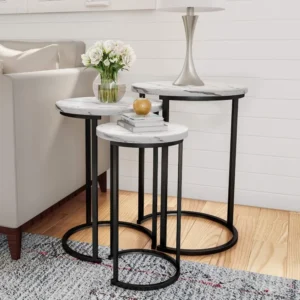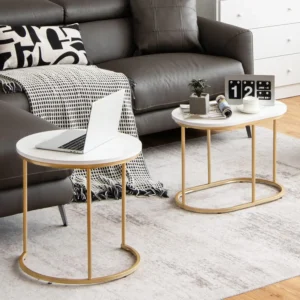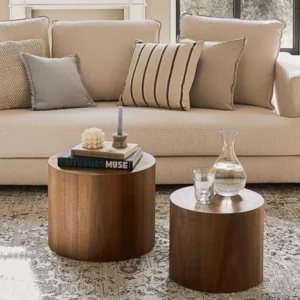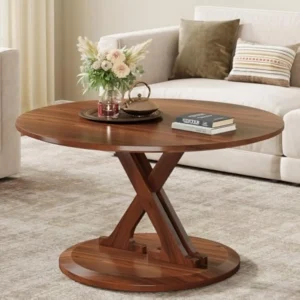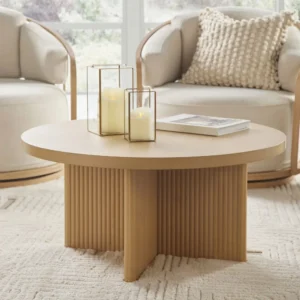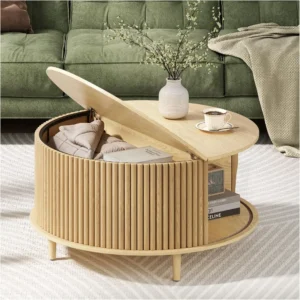What Are Nesting Coffee Tables and Why They’re Perfect Space-Savers
Nesting coffee tables are ingeniously designed sets of multiple tables in graduated sizes that fit one beneath another when not in use. This smart furniture solution allows you to have several functional surfaces while only taking up the floor space of a single table when nested together. The concept is brilliantly simple: smaller tables tuck completely under larger ones, creating a unified footprint that maximizes your available living area.
The space-saving principle behind these versatile pieces has roots in mid-century modern design, where form follows function and every element serves a purpose. This design philosophy aligns perfectly with contemporary needs for furniture that adapts to our changing lifestyles and smaller living spaces.
The physical nesting mechanism is straightforward yet effective. A typical three-piece set might occupy just 3 square feet when nested but provide 9 square feet of usable surface when separated. This remarkable space efficiency makes space-saving nesting coffee tables ideal for apartments, condos, or any home where maximizing floor space is essential.
Modern mid-century modern nesting coffee tables exemplify this blend of practicality and style, offering sleek profiles that complement rather than overwhelm smaller living environments. Their ability to combine form and function makes them particularly valuable in today’s compact urban homes.
The Science Behind Space-Saving: How Nesting Tables Work
The space-saving magic of nesting tables relies on precise geometric principles and thoughtful design. Each table in a set is carefully proportioned with specific height, width, and depth measurements to ensure perfect nesting. Typically, tables in a set have height differences of approximately 1-2 inches between each piece, with corresponding differences in length and width.
This graduated sizing creates a fundamental advantage: when nested, multiple tables occupy only the footprint of the largest piece. For example, a set of three tables might individually require 9 square feet of floor space when separated but only 3 square feet when nested—a 66% reduction in required floor area.
Beyond the raw square footage saved, nesting tables also reduce the clearance space needed around furniture. Each piece of furniture in a room typically requires about 18-24 inches of clearance for comfortable movement. By consolidating multiple tables into one nested unit, you eliminate the need for clearance space around each individual table.
Traffic flow—how people move through a space—dramatically improves with consolidated furniture. The space efficiency principles of nesting tables create clearer pathways through rooms, reducing obstacles and making small spaces feel more navigable and open. This improved circulation makes rooms not just physically larger but functionally more comfortable and usable.
Visual Impact: Before and After Nesting Tables in Small Spaces
The transformation that nesting tables bring to small spaces goes beyond mere practical concerns—it creates a visible and striking difference in how rooms feel and function. Consider a typical 10×12 foot (3×3.7 m) living room: before introducing nesting tables, separate coffee tables and side tables might occupy significant portions of the limited floor space, creating visual clutter and obstacle courses for movement.
After incorporating nesting tables, the same room gains breathing room as multiple surfaces consolidate into one footprint when not in use. This consolidation simplifies visual lines throughout the space, reducing the “busy” feeling that multiple furniture pieces can create. The floor becomes more visible, which psychologically makes the entire room appear larger and more open.
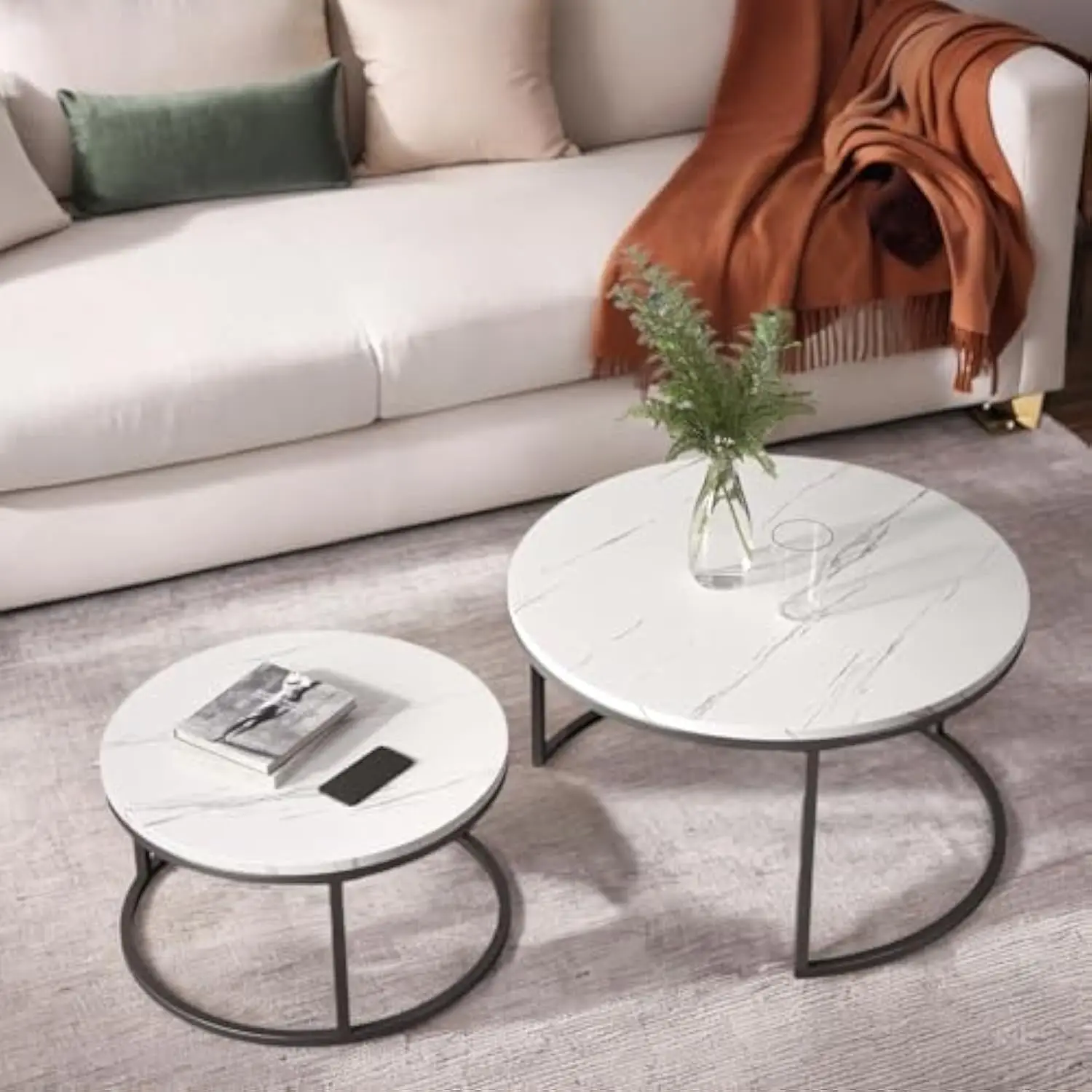
In a small apartment living room, nesting tables can transform a crowded seating area into a more welcoming space. When guests arrive, the tables can be separated to provide convenient surfaces for everyone; when alone, the nested configuration reclaims valuable floor area for other activities.
A compact entertainment area benefits similarly. During movie nights, the tables can remain nested, creating an open feel. For game nights or when serving snacks, the additional surfaces emerge to provide functionality without permanently sacrificing space. The nesting tables space-saving solution proves especially valuable in apartments where every square foot matters, allowing spaces to adapt to changing needs without structural modifications.
5 Functional Benefits Beyond Space-Saving
Versatile Configuration Options
Nesting tables excel at adaptability, allowing you to create various arrangements depending on your needs. You might position them in a cascading formation beside a sofa, spread them throughout a room for a party, or separate them to serve different seating areas. This flexibility lets you customize your space without purchasing multiple different tables.Enhanced Entertaining Capabilities
When hosting guests, having enough surface area for drinks, snacks, and personal items can be challenging in small spaces. Nesting tables solve this elegantly by providing multiple surfaces that can be distributed as needed. During gatherings, home entertaining with nesting tables becomes effortless as you can position individual tables near each guest, creating convenient personal surfaces that don’t crowd the room.Adaptability to Changing Room Layouts
Unlike bulky traditional coffee tables, nesting sets can easily adapt to different furniture arrangements. Rearranging your living room no longer means struggling with a large coffee table that only works in one position. The separate pieces can be reconfigured to complement virtually any seating arrangement, making seasonal changes or décor refreshes much simpler.Multi-Purpose Functionality
Each table in a nesting set can serve multiple purposes beyond being just a coffee table. The smaller tables make perfect plant stands, bedside tables, or display surfaces for treasured items. The larger pieces can function as work surfaces for laptops, dining areas for casual meals, or creative spaces for projects and hobbies.Mobility for Quick Space Transformation
Most nesting tables are designed to be relatively lightweight, allowing for easy movement around your home. This mobility means you can quickly transform spaces for different activities—clearing floor space for exercise, creating an impromptu dining area, or setting up a temporary workstation—all without the heavy lifting associated with traditional coffee tables.
Material and Design Considerations for Maximum Space Efficiency
The materials used in nesting coffee tables significantly impact both their space-saving potential and visual presence in a room. Glass tops create an airy, transparent quality that visually expands small spaces by allowing light to pass through and the eye to travel beyond the furniture. In contrast, solid wood provides warmth and stability but has more visual weight.
Metal-framed tables with slender profiles often appear to float in a space, minimizing their visual footprint while maintaining functionality. The combination of materials—like wood with metal legs or glass with wooden frames—can strike an ideal balance between visual lightness and practical durability.
The shape of nesting tables also plays a crucial role in space efficiency. Round tables eliminate sharp corners that can disrupt traffic flow, making them ideal for tight spaces where people need to navigate around furniture. Round coffee tables for space efficiency work particularly well in small apartments where every inch matters.
Square tables maximize surface area within a defined footprint and often nest more completely than other shapes. Rectangular tables offer versatility for different room layouts but require more consideration for clearance space. Choosing the best shape coffee table for small spaces depends on your specific room configuration and movement patterns.
Mid-century modern design principles—clean lines, organic shapes, and minimal ornamentation—enhance the space-saving qualities of nesting tables. These design elements create furniture that serves its function without unnecessary bulk. Tapered legs, another hallmark of mid-century design, lift the tables visually off the floor, creating a sense of lightness and space underneath the furniture that contributes to an airier room feel.
Strategic Placement: Maximizing Nesting Coffee Tables in Various Room Layouts
Thoughtful placement of nesting coffee tables dramatically affects how spacious a room feels and functions. In living rooms, position the nested set centrally within the seating arrangement, maintaining approximately 18 inches (45 cm) of clearance for comfortable leg room. When entertaining, the smaller tables can be pulled out and positioned beside armchairs or at either end of a sofa for convenient guest access.
For small apartments with multipurpose rooms, place nesting tables where they can easily transition between functions. Near a convertible sofa or daybed, they can serve as both coffee tables during the day and nightstands in the evening. In studio apartments, consider placing them against a wall when nested, where they can function as a console table, then bringing them center-stage when needed for entertaining.
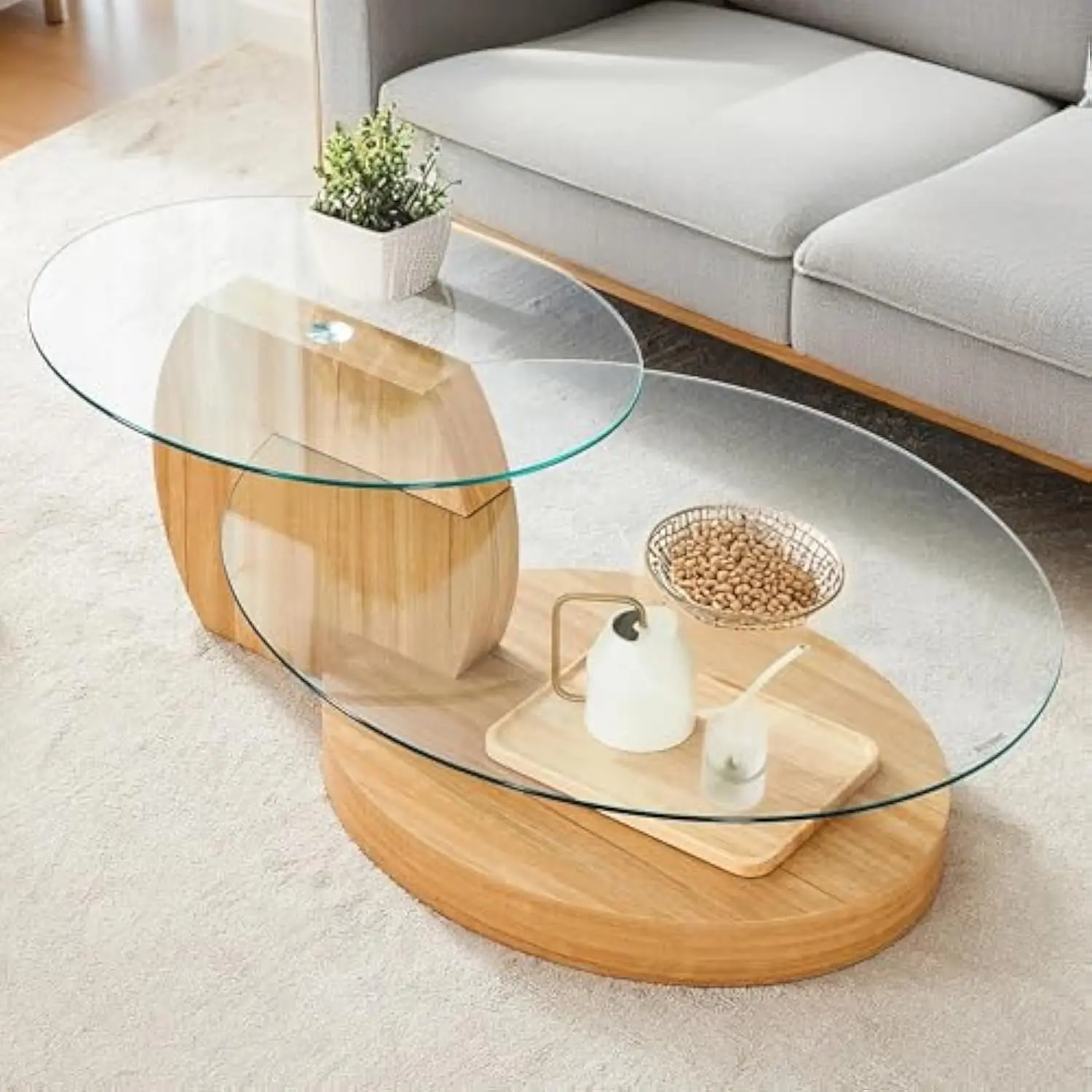
Traffic patterns should always guide placement decisions. Identify the main pathways through your space and ensure the tables—even when fully separated—don’t obstruct these routes. Diagonal placement can sometimes work better than parallel orientation to furniture in very tight spaces, creating more natural pathways around the tables.
Mid-century nesting coffee tables work exceptionally well when positioned to highlight their design features. Placing them where natural light can showcase their materials and craftsmanship adds visual interest while maintaining functionality. Consider sightlines from entry points to ensure the tables enhance rather than clutter the visual experience of entering the room.
How to Choose the Right Size Nesting Tables for Your Space
Selecting appropriately sized nesting tables requires careful consideration of your existing furniture and room dimensions:
- For standard living rooms, choose coffee tables that are approximately 16-18 inches (40-45 cm) high for comfortable use with typical sofas
- The largest table in your nesting set should be roughly two-thirds the length of your sofa for proper proportion
- Ensure at least 16 inches (40 cm) between the table and seating for comfortable leg room
- For very small spaces, consider round or oval tables that eliminate sharp corners and improve flow
- In rooms under 200 square feet (18.6 square meters), two-piece nesting sets may be more appropriate than larger sets
- The smallest table should be tall enough to be functional as a side table (generally 20-24 inches or 50-60 cm)
When selecting small coffee tables for small spaces, remember that proper scale matters more than simply choosing the smallest option. A properly proportioned table set will actually make the room feel more harmonious than one that’s too small for the surrounding furniture.
Consider the clearance needs of your specific lifestyle. Do you need space for stretching out legs? Do children need floor space for play? These factors might influence whether you select a compact two-piece set or a more extensive arrangement of tables.
Nesting Tables vs. Other Space-Saving Furniture: A Comparison
When considering space-saving furniture options, it’s helpful to understand how nesting tables compare with alternatives:
Nesting Tables vs. Lift-Top Coffee Tables
While lift-top tables provide adjustable height and sometimes include storage, they remain fixed in their footprint. Nesting tables offer multiple separate surfaces that can be distributed throughout a room—something lift-tops cannot provide. However, lift-tops excel at dual-height functionality in a single location.
Nesting Tables vs. Storage Ottomans
Storage ottomans offer hidden compartments and can double as seating, making them multifunctional in different ways than nesting tables. However, ottomans provide only one surface rather than multiple platforms. Nesting tables win for versatility of arrangement, while ottomans prevail for additional seating and storage.
Nesting Tables vs. Expandable Tables
Expandable or convertible tables typically transform from small to large through leaves or extending mechanisms. While they can provide one larger surface, they rarely offer the flexibility of multiple separate surfaces. Nesting tables adapt better to varied needs throughout a space, though expandable tables might better serve dedicated dining purposes.
Each option suits different priorities. Nesting versus folding coffee tables shows that nesting sets excel when multiple, mobile surfaces are valued, while folding options might better serve those needing one occasionally larger surface. The unique advantage of nesting tables lies in their ability to provide multiple independent surfaces without permanently claiming the floor space those surfaces would typically require.
Creative Ways to Use Nesting Tables Throughout Your Home
Beyond the living room, nesting tables offer versatile solutions throughout your home:
Bedroom Applications
Use the smaller table as a bedside surface for essentials while the larger table holds books, decorative items, or a small lamp. When needed, pull out the smaller table as a temporary surface for breakfast in bed or laptop work.Entryway and Hallway Solutions
Position the nested set against a wall in your entryway, using the visible top as a landing spot for keys and mail. When greeting multiple guests, extend the smaller tables to create additional surface areas for purses, packages, or drinks.Home Office Arrangements
The smallest nesting table can slide under a desk to hold reference materials within reach, then pull out when you need additional workspace. The larger tables can serve as mobile surfaces for collaboration or presentations.
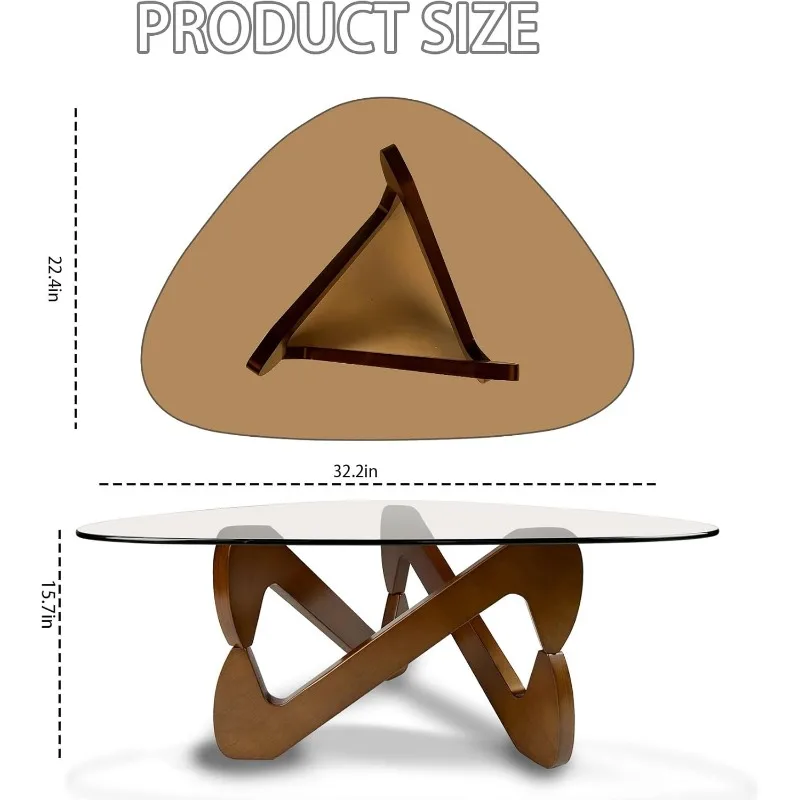
Dining Area Supplements
When hosting dinner parties, the smaller tables provide perfect serving stations for condiments, bread baskets, or drinks, keeping the dining table uncluttered without requiring permanent sideboard furniture.Display Configurations
Create a stepped display using all tables at once, with plants, photos, or collections arranged at various heights for visual interest. This approach transforms practical furniture into an artistic arrangement.
Nesting table sets for various uses provide exceptional adaptability, allowing you to reconfigure your space as needs change throughout the day or week without investing in multiple single-purpose furniture pieces.
Mid-Century Modern Nesting Side & End Tables, Mid-Century Modern Nesting Table Sets, Mid-Century Modern Round Side & End Tables
Price range: $239.35 through $273.06 Select options This product has multiple variants. The options may be chosen on the product pageMid-Century Modern Nesting Coffee Tables, Mid-Century Modern Nesting Table Sets
$361.45 Select options This product has multiple variants. The options may be chosen on the product pageMid-Century Modern Nesting Table Sets, Mid-Century Modern Round Coffee Tables
$462.57 Select options This product has multiple variants. The options may be chosen on the product pageMid-Century Modern Round Coffee Tables, Mid-Century Modern Small Coffee Tables
$452.73 Select options This product has multiple variants. The options may be chosen on the product pageMid-Century Modern Round Coffee Tables, Mid-Century Modern Solid Wood Coffee Tables
Price range: $522.31 through $559.78 Select options This product has multiple variants. The options may be chosen on the product pageMid-Century Modern Round Coffee Tables, Mid-Century Modern Small Coffee Tables
Price range: $459.95 through $488.75 Select options This product has multiple variants. The options may be chosen on the product page
Maintenance and Care to Preserve Space-Saving Functionality
Proper maintenance ensures your nesting tables continue to function smoothly and look beautiful for years to come. The nesting mechanism depends on precise alignment, so careful handling is essential to preserve this functionality.
For wood surfaces, use appropriate wood cleaners and avoid harsh chemicals that can damage finishes. Apply furniture polish occasionally to maintain the natural beauty of the material and provide protection. Glass tops require regular cleaning with appropriate glass cleaners to maintain clarity and prevent buildup that could affect the nesting alignment.
When moving nesting tables, always lift rather than drag them to prevent damage to table legs and floors. When separating nested tables, lift straight up rather than pulling outward to avoid stressing the legs. If you notice any wobbling or misalignment in the nesting, check for loose hardware and tighten as needed.
For seasonal storage or during moves, keep tables in their nested configuration and cover with breathable material to protect finishes. Before returning to use, check all components to ensure the nesting mechanism remains aligned and functional.
Regular inspection of joints, hardware, and surfaces helps identify potential issues before they affect functionality. The versatility and longevity of space-saving coffee tables depend on maintaining their structural integrity and finish quality.
Are Nesting Coffee Tables Right for Your Small Space? (Final Assessment)
Before investing in nesting coffee tables, consider these key questions to determine if they’re ideal for your situation:
How often do you need multiple surfaces?
If you regularly entertain or use table surfaces for various activities, nesting tables offer flexibility that single-surface options cannot match. If you rarely need more than one surface, simpler alternatives might suffice.
Is your floor space at a premium?
In truly compact spaces where every square foot matters, nesting tables provide exceptional efficiency. Their ability to expand when needed and contract when not makes them ideal for homes where space flexibility is essential.
Does your lifestyle involve frequent rearrangement?
For those who enjoy refreshing their space or need adaptable furniture for changing activities, nesting tables shine. If your furniture rarely moves once placed, you might not fully utilize their transformative potential.
Do you prefer clean lines and minimalist aesthetics?
Nesting tables typically feature streamlined designs that complement modern and mid-century décor. Their ability to reduce visual clutter aligns perfectly with minimalist design principles.
Nesting coffee tables offer remarkable space-saving benefits, providing three times the surface area while occupying the footprint of just one table when nested. Their versatility makes them appropriate for various living situations, from studio apartments to larger homes where space flexibility matters.
For alternatives that might better suit specific needs, consider small space coffee table alternatives that address unique requirements or aesthetic preferences. However, few options match the elegant efficiency and adaptability of well-designed nesting table sets in small spaces.


